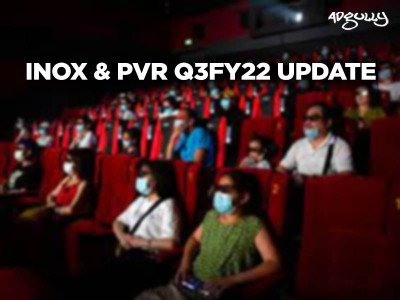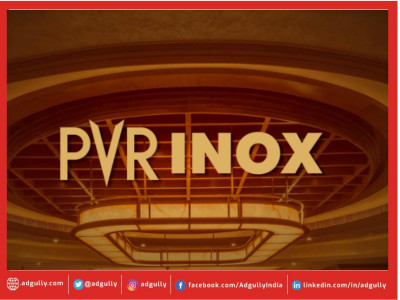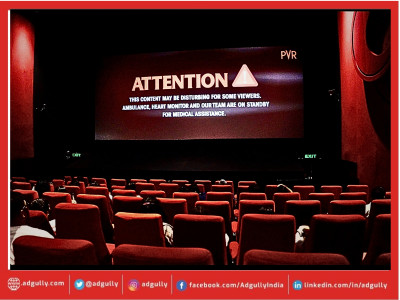Sharp recovery expected for exhibitors in FY23 post-March 2022
A sharp recovery is expected for exhibitors in FY 23 post-March 2022, on the big backlog of content pipeline with large-budget films and restrictions/lock-down waiver in major states, as COVID cases peak and fall at a faster pace versus those in Wave I/II. But, near-term weakness prevails as Q4FY22 maybe a quarter with little/nil new content supply amidst Omicron-led Wave III. This may lead to a monthly cash burn of ~INR 400mn for PVR as cinemas are open at very low occupancy, says Karan Taurani, Senior Vice President, Research Analyst (Media, Consumer Discretionary & Internet), Elara Capital.
“Trends around metrics such as SPH/ATP continue to be very compelling (28%/14% higher versus pre-COVID levels, respectively). But sustainability will be a key monitorable as prices move up with blockbuster/large content (Q3FY22 saw many blockbuster film releases). Also, watch for:
1) footfall recovery to pre-Covid levels as also for small/medium budget films,
2) ad revenue recovery and
3) reversal of the theatrical window (shift to 6-8 weeks).
These may determine the pace/path to pre-COVID revenues/profitability. We expect profitability to be ~20% lower versus pre-Covid levels in FY23, due to lower footfalls (small/medium budget films’ footfall may revive only in H2FY23) and less ad revenues. But if the pandemic ends, we expect strong growth in FY24 as structural content trends remain strong. We maintain Buy with a March 2023E TP of INR 2,100 based on 13.5x one-year forward EV/EBITDA,” Karan added.
On PVR Q3FY22 result First Cut he said: “PVR has reported a strong quarter with the beat on revenue which has largely come due to compelling growth in metrics like ATP and SPH, which may not be sustainable as we approach normalcy; we believe large budget films and Hollywood content generally tend to report higher growth in these operating metrics. In terms of other key metrics, footfalls remain down 44% vs pre-pandemic levels for the quarter despite multiple big-budget releases and ad. revenue will be the last one to recover in line with our expectation (declined 67% vs pre-pandemic levels. We believe in the positive impact of ad. revenue and footfall over the medium term will offset the negative impact of some reversals around ATP and SPH. In terms of profitability too, rental concessions may not be sustainable going ahead as developers are expected to move back to fixed rental models (pre-COVID arrangements) as footfall growth comes back gradually. Albeit above, we continue to believe that recovery path will be much faster for cinemas in the third wave as cinemas were not shut down in any major states except Delhi; expect Box Office to start seeing signs of strong recovery post-second week of March’22, as a big slate of content pipeline remains available for theatrical release.”
Quarterly highlights on PVR
- PVR reported revenue of INR 6142mn(Elara E: INR 4820mn), up 1252.8% YoY & 410.4% QoQ on a low base, helped by strong content across genres. Content flow from the Bollywood film industry commenced post-Maharashtra re-opening (from 22nd October onwards), resulting in business witnessing robust demand in the months of November and December 2021.
- The quarter was marked with strong performances from movies such as Sooryavanshi, Annaatthe, Eternals (during November’21), Spiderman: No way Home, Pushpa and 83 (during December’21), delivering healthy box office collections.
- On the percentage weekly footfall front in comparison to the pre-pandemic period, October noticed a recovery of 39%, November was at 58% whereas December was at 77% backed by the release of Spiderman and Pushpa.
- PVR has reported an operating profit of INR 1,649mn (including Ind-AS impact, v/s loss of 781mn in Q3FY21 and INR 681mn in Q2FY22, the company has stopped burning cash after six quarters. December 2021 witnessed strong business recovery with Exhibition revenue and EBITDA margin being very close to Pre Pandemic levels. EBITDA margin was at 26.9% including IND-AS impact vs our estimates of 26.3% (vs pre-pandemic levels of 33.6%)
- Amongst the key operating metrics, footfalls stood at 14.5mn (down 44% vs pre-pandemic levels), ATP stood at INR 239, up 18% QoQ, and up 13.8% v/s pre-COVID levels. F&B SPH stood at INR 129 which is the highest ever historically, up by 1% QoQ, and up 29% v/s pre-COVID levels during the quarter. Ad revenue was at INR 409mn (down 67% vs pre-pandemic levels – Q3FY20) for Q3FY22; however, for the month of Dec’22, ad revenue was down 52%, better than the qtr average due to big-budget releases.
- Company reported a net loss during the quarter(including SPI) of INR 102mn vs loss of INR 1,533mn in Q2FY22 & INR 492mn in Q3FY21, impacted by prevailing weakness on operating performance and deferred release of blockbuster content due to Wave III. On the overall end, Q3 FY 22 was the best quarter in the last 7 quarters with the Bollywood movie release calendar starting in Nov’21.
- Over its Opex, depreciation increased by 8% YoY, while interest costs declined by 1% YoY (14% & 3% higher v/s pre-COVID levels respectively), offset by the decline in other income by 65% YoY on account of rental concessions/waivers received during the quarter.
- Company launched 18 new screens during the year. This includes the 4 screens in Narsipatnam, Andhra Pradesh, 7 screens in Jio World Drive (including 1 drive-in theatre), Mumbai, 4 Director’s Cut screens in Ambience Mall, Gurgaon & 3 screens in Jamnagar, Gujarat.
The road to recovery remains steady despite the Omicron outbreak. We haven’t seen any large budget film going direct OTT in the last one month due to the Omicron wave, except Atrangi Re, which was announced much earlier than the outbreak. Economics remains favourable for large budget films to release in cinemas only as OTT isn’t a threat anymore; as normalcy approaches and confidence emerges, we believe small/medium budget films too will make a strong come back on cinemas as producers of these films too are okay to release in theatres if restrictions are eased out. On various terms, we expect the release window to come back to pre Covid levels after 3-6 months of opening up beyond March’22; distributor shares had already come back to pre-Covid largely for states which were at 100% occupancy, expect this also to come back to pre-Covid terms much earlier than window arrangements
About Inox Leisure Q3FY22 update, Karan said: “A huge backlog of the content pipeline, headlined by large-budget films, and restrictions/lockdown reversal in major states, as COVID cases peak and fall at a faster clip versus those during Wave I/II. However, near-term weakness prevails as Q4FY22 will likely be a quarter with little or no new content supply in the midst of Wave III (Omicron). This may lead to a cash burn of ~INR 250mn per month for INOL, as cinemas are open at very low occupancy levels.
He further added: “Trends on metrics such as SPH/ATP continue to be compelling (19.8%/10.8% higher versus pre-COVID levels, respectively). But sustainability will be a key monitorable as prices move up with blockbuster/large content (Q3FY22 saw multiple blockbuster film releases). Apart from the above, watch for: 1) footfall recovery to pre-Covid levels and footfalls for small/medium budget films, 2) ad revenue recovery and 3) reversal of the theatrical window (shift to 6-8 weeks). These may determine the pace/path to pre-Covid revenues/profitability. We expect profitability to be ~20% lower versus pre-Covid levels in FY23E, due to lower footfalls (small/medium budget films’ footfall may revive only in H2FY23) and less ad revenue. But if the pandemic ends, we expect strong growth in FY24 versus pre-COVID levels as structural content trends are strong. Maintain Buy with a March 2023E TP of INR 520 based on 11.5x one-year forward EV/EBITDA.”
















Share
Facebook
YouTube
Tweet
Twitter
LinkedIn